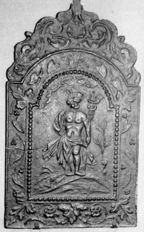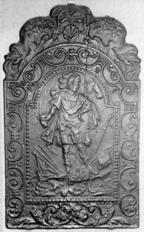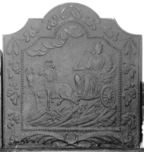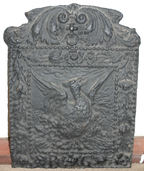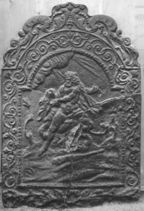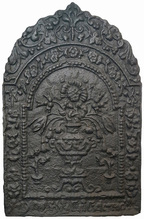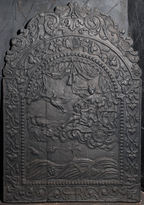-
309
Description: Central panel, cavetto-canted rectangle with arch; bud and annulet edging (in alternate threes); pictorial panel portraying Europa being carried to sea by Zeus, disguised as a bull; two female attendants wave from the right shore; two putti attend, one below with a bow and arrow; trees to right and left; clouds and sun above. Same shaped, fillet-edged border with floral scrolls top and sides; at the bottom, a cartouche bearing EB monogram between oak leaf and acorn fronds; on top, central scallop shell between floral scrolls with dolphin’s heads.
Notes: The central design is closely based on an illustration by Bernard Salomon, first published in a 1557 edition of Ovid’s Metamorphoses and copied in subsequent editions by Virgil Solis (1514-62). The initials, EB, are likely to be those of the pattern maker. The similarity between the execution of this picture and those on firebacks bearing the SHR monogram suggests the possibility of a common source. Ten rivets are the result of later repair.
Copies of this fireback are known.
Inscription: EB
- Decoration tags:
- 'Dutch' (shape)
- fillet (edging)
- whole carved pattern
- pictorial
- mythological
- monogram
- text
- animals
- humans
Manufactured: in the early 18th century in England.
Current location: Hampton Court Palace, Richmond, Greater London, England.
Museum number: 1107 (part of the Royal Collection museum group)
- Attached to series:
- EB series
- British 'Dutch' style firebacks
-
111
Description: 'Dutch' style; arched rectangular shaped central panel with bead edging, semi-naked figure holding a caduceus in his left hand, standing on a mound with a tree to the right and clouds above; arched rectangular shaped border with fillet edging and an ivy and acanthus leaf pattern; on top an arrangement of swirled foliage.
Notes: The figure is Hermes/Mercury, one of a set of 'Eight Deities' engraved by Hendrick Goltzius (1592), after Polidoro da Caravaggio. Formerly part of the Ade Collection (from Grove Hill, Hellingly, Sussex).
Copies of this fireback are known.
- Decoration tags:
- 'Dutch' (shape)
- fillet (edging)
- whole carved pattern
- mythological
- humans
Manufactured: in the mid to late 17th century in England.
Current location: Hastings Museum and Art Gallery, John's Place, Bohemia Road, Hastings, East Sussex, England.
Museum number: HASMG: 1952.51.34 (LA 782) (part of the Hastings Museum museum group)
- Attached to series:
- British 'Dutch' style firebacks
- Eight Deities series
-
130
Description: Arched rectangular shaped central panel with bead on fillet edging; helmeted figure of Mars holding a cutlass in his right hand, standing on a field of flags, spears and cannon; 'Palladian' shaped border with fillet edging enclosing a repeated scrollwork pattern with floral arrangement at base; on top, symmetrical arrangement of scallop shell between two sea serpents and plant fronds.
Notes: Although in the 'Dutch'; style, an absence of this type in continental collections suggests an British source. Formerly part of the Ade Collection (from Grove Hill, Hellingly, Sussex).
Copies of this fireback are known.
- Decoration tags:
- 'Dutch' (shape)
- fillet (edging)
- whole carved pattern
- mythological
- humans
Manufactured: in the late 17th to early 18th century in England.
Current location: Hastings Museum and Art Gallery, John's Place, Bohemia Road, Hastings, East Sussex, England.
Museum number: HASMG: 1952.51.32 (part of the Hastings Museum museum group)
- Attached to series:
- British 'Dutch' style firebacks
-
143
Description: Central panel of arched rectangular shape with cavetto canted corners and bead edging; crowned female figure holding a sceptre in her right hand, seated in a chariot drawn by two caparisoned ponies, a cornucopia at their feet; below, sloping ground with plants, clouds with rain above; identically shaped border with fillet edging and symmetrical swags of flowers and drapery suspended from ribbons; at the base two symmetrical palm fronds tied with a ribbon.
Notes: The figure may represent Ceres, goddess of plenty. The fireback is one of a series designed and made in England, copying the prevailing 'Dutch' style. Its style echoes that of a fireback pattern preserved at Rottingdean Grange, Sussex. Formerly part of the Ade Collection (from Grove Hill, Hellingly, Sussex).
Copies of this fireback are known.
- Decoration tags:
- cavetto-canted arched rectangular (shape)
- fillet (edging)
- whole carved pattern
- mythological
- animals
- humans
Manufactured: in the early 18th century possibly in the Weald area of England.
Current location: Hastings Museum and Art Gallery, John's Place, Bohemia Road, Hastings, East Sussex, England.
Museum number: HASMG: 1952.51.63 (part of the Hastings Museum museum group)
- Attached to series:
- Mayfield 'Dutch' series
- British 'Dutch' style firebacks
-
154
Description: Rectangular central panel with bead edging; a phoenix, with wings displayed, rising from the flames; rectangular border with bead edging, flowers and leaves festooned from a central flower; initials split either side of a flower at the base; on top, symmetrical swirled leaves.
Notes: Although similar to 'Dutch' types made in north Germany, this is probably an English design. A fireback bearing a phoenix was one of three designs ordered by Trubshaw's, ironmongers of London and Birmingham, from George Sitwell's furnace at Foxbrooke, Derbyshire, in the 1660s. Formerly part of the Ade Collection (from Grove Hill, Hellingly, Sussex).
Copies of this fireback are known.
Inscription: R (or B) G
- Decoration tags:
- quasi-arched rectangular (shape)
- bead (edging)
- whole carved pattern
- individual letters
- mythological
- text
- animals
Manufactured: in the mid to late 17th century in England.
Current location: Hastings Museum and Art Gallery, John's Place, Bohemia Road, Hastings, East Sussex, England.
Museum number: HASMG: 1952.51.16 (part of the Hastings Museum museum group)
Citation: Lloyd, N., 1925, 'Domestic Ironwork I', Architectural Review, 58, pp. 58-67.
Citation: Riden, P., 1985, George Sitwell's Letterbook, 1662-66 (Derbyshire Record Society vol. 10).
- Attached to series:
- British 'Dutch' style firebacks
- Phoenix firebacks
-
155
Description: Arched rectangular shaped central panel with paternost bead edging; Hercules/Herakles slaying the Nemean lion on a ground with small trees, his club lying at his feet; above, clouds and sun rays; arched rectangular shaped border with fillet edging, symmetrical arrangement of swirled tendrils, floral wreath at base; on top, symmetrical arrangement of foliage.
Notes: The image is taken from an engraving by Gerard de Jode, from his series 'The Labours of Hercules', after Marcus Geeraerts, 1519 - 1591. One of many English firebacks which copied 'Dutch' styles. Formerly part of the Ade Collection (from Grove Hill, Hellingly, Sussex).
Copies of this fireback are known.
- Decoration tags:
- 'Dutch' (shape)
- fillet (edging)
- whole carved pattern
- pictorial
- mythological
- humans
Manufactured: in the early 18th century in England.
Current location: Hastings Museum and Art Gallery, John's Place, Bohemia Road, Hastings, East Sussex, England.
Museum number: HASMG: 1952.51.27 (part of the Hastings Museum museum group)
- Attached to series:
- British 'Dutch' style firebacks
-
160
Description: Arched rectangular shaped panel with fillet edging; two Salomonic columns supporting a beaded arch; standing figure of Atlas supporting a globe, on ground with plants, and two swags of fruit and leaves suspended from the centre of the arch to the capitals of the columns; above the beaded arch, symmetrical swirls of fruit and foliage; on top, a scallop shell between two sea serpents.
Notes: Probably an English design copying the north German 'Dutch' style.
Copies of this fireback are known.
- Decoration tags:
- 'Dutch' (shape)
- fillet (edging)
- whole carved pattern
- mythological
- architectural
- humans
- plants
- objects
Manufactured: in the late 17th to early 18th century in England.
Current location: Hastings Museum and Art Gallery, John's Place, Bohemia Road, Hastings, East Sussex, England.
Museum number: HASMG: 1917.196.6 (part of the Hastings Museum museum group)
Citation: Butterfield, W. R., 1916, 'Old Wealden Firebacks', The Connoisseur, 46, pp. 197-209.
Citation: Lloyd, N., 1925, 'Domestic Ironwork I', Architectural Review, 58, pp. 58-67.
Citation: Baines, J. M., 1958, Wealden Firebacks (Hastings Museum).
- Attached to series:
- British 'Dutch' style firebacks
-
163
Description: Arched rectangular shape with fillet edging; tall, arched central panel with bead edging (top and sides); flying bird in arch, with two small trees below, and two figures, one with a staff in his right hand, and a dog, at the bottom; two side panels with similar cascades of flowers; narrow base panel with fillet edging and symmetrical floral arrangement; on top, a scallop shell between two symmetrical lines of trailing flowers.
Notes: The figures may be Venus and Adonis, the bird aboive being a dove; probably an English design based on the 'Dutch' style. Formerly part of the Ade Collection (from Grove Hill, Hellingly, Sussex).
Manufactured: in the late 17th to early 18th century in England.
Current location: Hastings Museum and Art Gallery, John's Place, Bohemia Road, Hastings, East Sussex, England.
Museum number: HASMG: 1952.51.31 (part of the Hastings Museum museum group)
- Attached to series:
- British 'Dutch' style firebacks
-
227
Description: Arched rectangular shaped central panel with bead edging on a wide fillet; two-handled vase with assorted flowers on a stand with scrolled legs; a plant pot on each side; arched rectangular shaped border with fillet edging, symmetrical floral fronds descending from a rose, top centre, with a looped 'W' in each shoulder; inscription at base; on top, symmetrical scrolled plant tendrils.
Notes: The second largest of six flower vase designs in this series; a recast plate. All incorporate the looped 'W' motif which may be intended to identify the pattern maker. The inscription translates as 'God is our strength'.
Copies of this fireback are known.
Inscription: 17 DVW Ydyw Ein Cadernid 24
Manufactured: in 1724 in England.
Current location: not known.
- Attached to series:
- 1724 series
- Welsh inscription series
- British 'Dutch' style firebacks
-
327
Description: Arched rectangular shaped central panel with open-bud edging; pictorial: Venus in her chariot drawn by doves, with her child, Cupid; a heron flies away to the left; above are swagged curtains and a pair of tassels, below is a landscape; arched rectangular shaped border with fillet edging, a scallop shell top centre with symmetrical arrangement of vine and acanthus leaves and tendrils; the monogram, SHR, bottom centre; above is a symmetrical design of scrolled floral tendrils.
Notes: The design is derived from a personification of the planet Venus in 'Planetarum effectus et eorum in signis zodiaci', by Marten de Vos (1585); the flying heron has been copied from a print by Wenceslaus Hollar c.1658. The theft, in 1699, from a Thames-side warehouse of several firebacks, included '6 of Venus in a Chariot with Doves', which is likely to refer to this type (Post Boy 11-14 Nov. 1699).
Copies of this fireback are known.
Inscription: SHR
- Decoration tags:
- 'Dutch' (shape)
- fillet (edging)
- whole carved pattern
- planklines
- pictorial
- mythological
- allegorical
- text
- animals
- humans
Manufactured: in the late 17th century in England.
Current location: Horsham Museum, Causeway, Horsham, West Sussex, England.
(part of the Horsham Museum museum group)
- Attached to series:
- SHR series
- British 'Dutch' style firebacks
- De Vos Planets series

